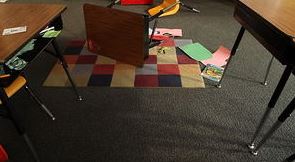 “I’ll be glad when Trump is president and he sends you people back where you belong!”
“I’ll be glad when Trump is president and he sends you people back where you belong!”
The teacher was still red in the face, remembering how shocked and helpless she felt when she heard one of her students shout this at a group of Hispanic students in the lunch room.
A few weeks ago I wondered in a blog post how long it would be before the rhetoric of our leader hopefuls would trickle into the lunchrooms and play yards of our schools. State policies on bullying focus on what happens inside the school building but bullying thrives because it is part of a larger system, influenced by family, community and national culture.
Teachers and staff often feel helpless to address this level of intolerance when they are aware that students are often repeating beliefs encouraged at home. “How can I tell them what they are doing is wrong when they go home and hear a parent nodding in support of ‘what’s wrong with America’?” So often, these kinds of comments go unaddressed or briefly reprimanded and nothing changes in the culture.
Of course, it isn’t only the Hispanic students who will suffer as the result of this comment. Allowing the statement to go unaddressed sends the message that anyone who is different from the dominant culture of the school is not welcome. Bullying targets differences, undermines students’ sense of belonging and works against goals for diverse learning environments.
But what of the point that students will hear these messages at home or in the community? One of the jobs of schools is to offer students the chance to experience different ways of thinking and relating to others and to prepare them to live and work with people different from themselves. Holding up that purpose in the face of intolerance can be intimidating, particularly if a teacher does not have the support of administration to back her up.
What can you do when you hear intolerance at your school?
- Interrupt it immediately. Comment on the behavior and the impact it has on you. (Shaming or punishing the speaker is likely to have the reverse effect). Try “That statement was hurtful and I am sad to see students treated that way in our school.”
- Stand your ground. Speak calmly but firmly. Do not allow yourself to get pulled into a debate or discussion in that moment. It is fine to assert that “This may be acceptable speech at home, but here, we treat each other with respect.”
- Be a broken record. Having a phrase at the ready can help you feel calm when addressing comments such as this. Decide with your colleagues what the message will be and use it every single time.
- Look for teachable moments. Interrupting comments immediately is the first step to addressing the culture in your school. Look for opportunities to deepen students’ understanding and empathy through social emotional learning curricula and lessons. Teaching Tolerance, out of the Southern Poverty Law Center, is a wonderful resource for teachers looking to support student’s social/emotional learning and cultural awareness. org
You may not be able to change what is taught at home and in the community, but you can create a place where students can experience a different possibility.





